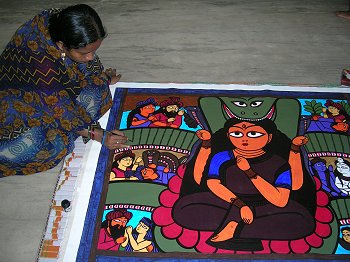 |
 |
To the roots:
Camp on tribal paintings
April 24, 2009 These national artists take you to the roots of Indian art and painting. One wonders whether ethnic art has stagnated over centuries. Expressions of life, society, religion and philosophy of the community, myth and contemporary themes jostle. Yes, time leaves his foot prints. Folk art has remained the undercurrents of many innovations that ushered modern art in India. And it has given sustenance to experiments as an enriching source for artists. Surprisingly, women dominated the camp. Indeed it was women who decorated their hutments; wove their fabric; prepared paints culled from leaves and stones. Gaisingduan is from Manipur, painting Tarang-kai, celestial home with motifs of sun, moon and stars - celestial wonders. "We do this as part of kabui rituals during festivals," he said. Abuanlu Kamei reveals her joy of creation by humming as she painted a traditional dress material that goes with festivals in Manipur. Art has sprung from leisurely activities at home, for ritualistic ceremonies on cloth. Mithila paintings originated in the Mithila area of Bihar. Associated with Sita's home, stories of Ramayana is central to the art. Also known as Madhubani paintings, it is rich in art symbolism, with a rare simplicity and beauty. Activities of life, ornate floral patterns with inevitable Hindu icons forms its distinct style. A few hand-painted saris for sale shows the vibrant colors used, the small figures painted, and the intricate details that make the painting unique. Urmila Devi and her husband Paswan teach even foreigners, back home in Mithila. Yes, this traditional folk art has succeeded in creating a place for itself internationally and so is recognized worldwide. Warli paintings from Maharashtra and Gujarat belong to the tribe known as Warli and it's said their tradition dates back to 2500 BC. Women decorated their walls for festivals; bridal chamber had a celebratory cast traditionally. Later, like all tribal arts, the paintings got transferred on to fabric and paper. The distinguishing feature of Warli paintings is the use of geometric designs: triangles, circles, squares. Dots and crooked lines depict humans, animals and plants. The artists celebrate the joy of community life: hunting, fishing, farming, wedding and birth; festivals and dance. Tiny figures fill a wide canvas as they draw in white. These monochromatic depictions on ochre red background express the folk customs, beliefs, and imaginations of a community. The white color goes back to its origin whence they used rice paste and water mixed in a gum for a binder.
 Kalampari artists come from Gujarat. Kalampari is well known in Kerala because of their presence in many camps held over the years. Gond painters from Madhya Pradesh who paint colorful figures of animals and people, attract attention. The simplicity of the tribal arts like the people who create them is untouched by modernity. For them the indigenous art is sacrosanct. It is urban artists who go to these roots to experiment and create innovative designs and trends. As the camp came to a close on 10th April, it is heartening to note that well-wishers help these marginalized artists to rediscover themselves in a changed scenario. Padma
Jayaraj is a freelance writer and a regular contributor to www.narthaki.com
|